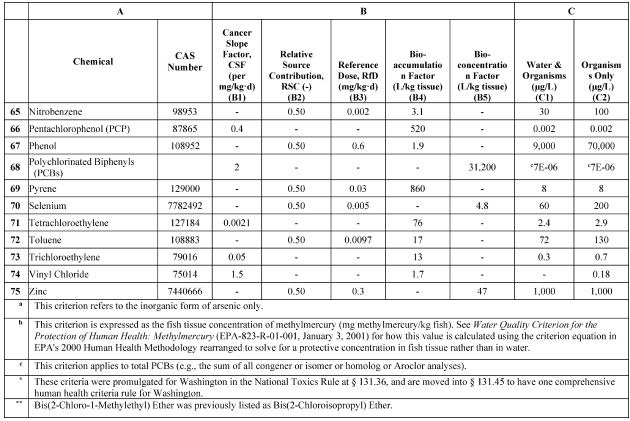['Water Programs']
['Watershed Management', 'Water Quality']
05/14/2024
...
(a) Scope. This section promulgates human health criteria for priority toxic pollutants in surface waters in Washington.
(b) Criteria for priority toxic pollutants in Washington. The applicable human health criteria are shown in table 1 to this paragraph (b).



(c) Applicability. (1) The criteria in paragraph (b) of this section apply to waters with Washington's designated uses cited in paragraph (d) of this section and apply concurrently with other applicable water quality criteria.
(2) The criteria established in this section are subject to Washington's general rules of applicability in the same way and to the same extent as are other federally promulgated and state-adopted numeric criteria when applied to the same use classifications in paragraph (d) of this section.
(i) For all waters with mixing zone regulations or implementation procedures, the criteria apply at the appropriate locations within or at the boundary of the mixing zones; otherwise the criteria apply throughout the waterbody including at the end of any discharge pipe, conveyance or other discharge point within the waterbody.
(ii) The state must not use a low flow value below which numeric non-carcinogen and carcinogen human health criteria can be exceeded that is less stringent than the harmonic mean flow for waters suitable for the establishment of low flow return frequencies (i.e., streams and rivers). Harmonic mean flow is a long-term mean flow value calculated by dividing the number of daily flows analyzed by the sum of the reciprocals of those daily flows.
(iii) If the state does not have such a low flow value for numeric criteria, then none will apply and the criteria in paragraph (b) of this section herein apply at all flows.
(d) Applicable use designations. (1) All waters in Washington assigned to the following use classifications are subject to the criteria identified in paragraph (d)(2) of this section:
(i) Fresh waters—
(A) Miscellaneous uses: Harvesting (Fish harvesting);
(B) Recreational uses;
(C) Water supply uses: Domestic water (Domestic water supply);
(ii) Marine waters—
(A) Miscellaneous uses: Harvesting (Salmonid and other fish harvesting, and crustacean and other shellfish (crabs, shrimp, scallops, etc.) harvesting);
(B) Recreational uses;
(C) Shellfish harvesting: Shellfish harvest (Shellfish (clam, oyster, and mussel) harvesting)
Note to paragraph (d)(1): The source of these uses is Washington Administrative Code 173-201A-600 for Fresh waters and 173-201A-610 for Marine waters.
(2) For Washington waters that include the use classification of Domestic Water, the criteria in column C1 and the methylmercury criterion in column C2 of Table 1 in paragraph (b) of this section apply. For Washington waters that include any of the following use classifications but do not include the use classification of Domestic Water, the criteria in column C2 of Table 1 in paragraph (b) of this section apply: Harvesting (fresh and marine waters), Recreational Uses (fresh and marine waters), and Shellfish Harvesting.
[81 FR 85435, Nov. 28, 2016; 85 FR 28498, May 13, 2020; 87 FR 69198, Nov. 18, 2022]
['Water Programs']
['Watershed Management', 'Water Quality']
UPGRADE TO CONTINUE READING
Load More
J. J. Keller is the trusted source for DOT / Transportation, OSHA / Workplace Safety, Human Resources, Construction Safety and Hazmat / Hazardous Materials regulation compliance products and services. J. J. Keller helps you increase safety awareness, reduce risk, follow best practices, improve safety training, and stay current with changing regulations.
Copyright 2025 J. J. Keller & Associate, Inc. For re-use options please contact copyright@jjkeller.com or call 800-558-5011.
